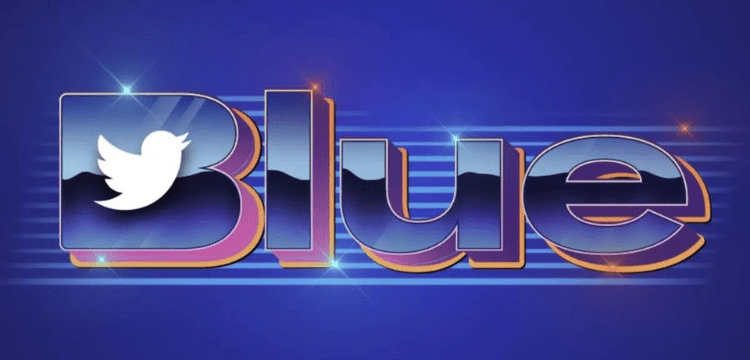[vc_row][vc_column][vc_column_text dp_text_size=”size-4″]According to Twitter, legacy Twitter checkmarks will be phased out on April 1st, and in the future, the only way to obtain the coveted blue badge will be to pay for a Twitter Blue subscription. That raises an important question for Twitter and its owner, Elon Musk: Will that nail finally drive more people to sign up for the social network’s premium tier?
So far, adoption has been disappointing. According to data from app intelligence firm Sensor Tower, Twitter Blue has only collected $11 million in mobile subscriptions since relaunching three months ago as a major push into non-advertising-based revenue.
The $11 million figure is significant because Twitter is betting on Twitter Blue at a time when advertising, which has traditionally accounted for the vast majority of Twitter’s revenue, is in steep decline.
This is due, in part, to the general state of the economy, which has reduced marketing spending. However, advertisers have been hesitant to recommit to Twitter due to its rapid-fire changes, chaotic missteps, and threats to overall brand safety as Elon Musk rolled back previous safeguards. Twitter has since attempted to repair some of those relationships, including partnerships with adtech firms DoubleVerify and Integral Ad Science (IAS), but it is unclear how much revenue has improved as a result.
Also Read: Meta working on new social networking app to compete Twitter.
While $11 million is a small sum, it should be noted that this estimate excludes web-based subscriptions. The company also cannot determine who is paying for annual or monthly Blue subscriptions. The figures apply to the 20 markets where Blue was introduced prior to this week. Twitter did not make the service available globally until yesterday.
Sensor Tower estimates that Blue has more than 385,000 mobile subscribers worldwide on both iOS and Android, according to information shared with TechCrunch. The United States is its largest market, with 246,000 subscribers spending approximately $8 million via mobile devices.
“The loss of advertising demand, fueled both by broader macro uncertainty and Twitter-specific platform issues, has made alternative revenue streams quite appealing for the social media network,” said Abe Yousef, senior insights analyst at Sensor Tower.
It’s not clear how many users overall Twitter has currently, but as of Q2 last year, it said it had nearly 238 million monetizable daily active users (its own metric).
According to multiple reports, the company has been losing advertisers since Musk purchased Twitter and took over as CEO. The Wall Street Journal reported earlier this month that earnings for December 2022, which Twitter shared with investors, showed a 40% drop in revenue. As a result, Twitter’s earnings were adjusted. To put the $11 million in Twitter Blue mobile subscriptions into perspective, in Q2 2022, the most recent quarterly earnings statement released by Twitter (when it was still a publicly traded company), advertising accounted for all but $100,000 of Twitter’s nearly $1.2 billion in revenue.
There are also concerns about how much of that $11 million will be recurring in the coming months. Sensor Tower believes annual subscriptions will be a “minimal” portion of the $11 million, according to Yousef.
“Social media users are typically less likely to spend $100+ all at once versus $11 for 1-2 months to try out the service and see if they enjoy using it,” he explained.
Twitter Blue was initially launched in limited markets in 2021 as a service aimed at power users, with perks that may have only seemed significant to that group — bookmarking, the ability to “redo” a Tweet, ad-free reading of news articles, and early access to experiments via Twitter Labs, to name a few.
Blue, however, has taken on a different emphasis under Musk, as part of his strategy to rebuild the company’s revenue model. As a result, the features — both those that are currently available and those that Twitter promises will be available soon — feel more central to the mainstream Twitter experience.
Blue users can edit tweets, upload larger videos, have a “reader” view for longer threads, and more in addition to badges. It also promises (but has yet to launch) fewer ads and greater visibility in replies for Blue users.
Subscriptions cost $11 per month (or the equivalent in your country) on iOS and Android, and $8 on the web. (The higher mobile price is due to app store cut).
According to the new data, U.S. Twitter users on mobile devices spent nearly $1.8 million on Twitter Blue subscriptions in the first month following the relaunch in December. According to Yousef, this indicates that the service received over 160,000 mobile subscribers in the country during its first month of relaunch.
However, when it comes to driving business in its strongest markets, the company still has some work to do. Twitter Blue was launched in February in India, the company’s second-largest user market after the United States. Sensor Tower claims that only $301,000 has been spent on Blue since then, which equates to approximately 17,000 mobile subscriptions.
Following the local launch of Twitter Blue, India became Twitter’s sixth-largest mobile market in terms of in-app purchases, according to Yousef. According to the analyst, the country was Twitter’s eighth-largest mobile market for in-app purchases nearly 10 months before the company’s acquisition and subsequent launch and relaunch of Twitter Blue.
Sensor Tower data is derived from in-app purchases made through Twitter’s mobile apps. Aside from Twitter Blue, the company offers other in-app purchases. However, Yousef stated that given the significant increases in in-app purchase revenue observed following the relaunch of Twitter Blue, the majority of that revenue can be attributed to the subscription product, with boosted tweets and other in-app purchases providing very little in-app purchase revenue.[/vc_column_text][/vc_column][/vc_row]











